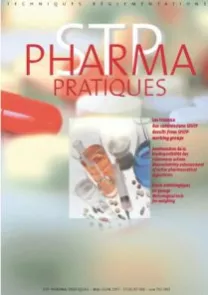All publications
Evolution of the Microstructure of Sustained-release Matrix Tablets during Dissolution and Storage
Indian J Pharm Sci 2018;80(6):1011-1020 - Sep 2018
Solubilisation behaviour of poorly water-soluble drugs during digestion of solid SMEDDS
European Journal of Pharmaceutics and Biopharmaceutics, Volume 130, Pages 236-246 - Sep 2018
Development of a daphnetin transdermal patch using chemical enhancer strategy: insights of the enhancement effect of Transcutol P and the assessment of pharmacodynamics.
Drug Dev Ind Pharm. 2018 Oct;44(10):1642-1649. doi: 10.1080/03639045.2018.1483391. Epub 2018 Jul 2. - Jul 2018
A patch for transdermal delivery of daphnetin was developed using Transcutol® P as permeation enhancer.
The study showed:
10% Transcutol® P led to a significant increase in drug release from the patch.
Patch exhibited analgesic and anti-inflammatory activity
Gels, crèmes, formes semi-solides : de leur développement à leur enregistrement. [Gels, creams, semi-solid forms: from their development to their registration]
STP Pharma Pratiques – September October 2018 – 28(5) 181-250 – ISSN 1157-1497 - 2018
The SFSTP commission on topical dosage forms published an article reviewing all the steps for their development to registration.
Interestingly this article is both in French and English languages.
Table of content:
Introduction
I Definition of a semi-solid
II Tests and studies applicable in evaluation of semi-solid forms from development up to the phase of routine use
2.1 Regulatory requirements
2.2 Relevant tests in development
2.2.1 Conventional characterization tests
2.2.2 Characterization tests specified to evaluate performance of the formulation
2.2.3 Additional characterization tests specified to evaluate performance of the formulation
III QbD approach related to the formulation
3.1 Different elements of the QbD
3.2 When to set up QbD ?
3.3 Definition of QTPP
3.4 CQAs toward evaluation of risks of process
3.5 Example of CMAs studied in case of a semi-solid formulation
3.6 Example of CPPs studied in case of a semi-solid formulation
Conclusion
IV Conclusions and perspectives

Lipid-based nanosuspensions for oral delivery of peptides, a critical review
International Journal of Pharmaceutics, Volume 541, Issues 1–2, Pages 117–135 - Apr 2018
In this review article, the authors describe:
the different techniques used to prepare Solid Lipid Nanoparticles and Nanostructured Lipid Carriers
the methods used to assess the protective effects of the carriers on peptides
the techniques used to measure the permeability enhancement
Self-emulsifying peptide drug delivery systems: How to make them highly mucus permeating
International Journal of Pharmaceutics, Volume 538, Issues 1–2, Pages 159-166 - Mar 2018
The aim of this study was to evaluate the mucus permeating properties of self-emulsifying drug delivery systems (SEDDS). Small droplet size and negative zeta potential of SEDDS could be identified as key parameters for their mucus permeating properties.
Size characterization of lipid-based self-emulsifying pharmaceutical excipients during lipolysis using Taylor dispersion analysis with fluorescence detection
International Journal of Pharmaceutics, Volume 537, Issues 1–2, Pages 94–101 - Feb 2018
In this work, the lipolysis of Labrasol® and Gelucire® 44/14 , two lipid based self-emulsifying drug delivery systems, by pancreatic enzymes and under conditions mimicking the gastrointestinal tract is followed by Taylor dispersion analysis. Results show that, Labrasol® droplets decrease exponentially in size with lipolysis time, whereas Gelucire® 44/14 droplets increased sigmoïdally in size. Even after 120 min lipolysis, both systems maintain a solubilizing capacity of the hydrophobic marker.
Evaluation of the digestibility of solid lipid nanoparticles of glyceryl dibehenate produced by two techniques: Ultrasonication and spray-flash evaporation
European Journal of Pharmaceutical Sciences , Volume 111, Pages 91-95 https://doi.org/10.1016/j.ejps.2017.09.049 - Jan 2018
In this study, solid lipid nanoparticles (SLN) of glyceryl dibehenate are produced by two methods and evaluated for digestion using the in vitro lipolysis test.
By ultrasonication, SLN have a mean particle size of 180 nm and showed a limited digestion by lipase.
By spray-flash evaporation, SLN particle size ranges from 235 to 411 nm, depending on process conditions and were not digested by lipase.
Inclusion of digestible surfactants in solid SMEDDS formulation removes lag time and influences the formation of structured particles during digestion
The AAPS Journal, Vol. 19, No. 3 - May 2017
The objective of this study is to evaluate how solid self-microemulsifying drug delivery systems (SMEDDS) behave during digestion. SMEDDS containing Gelucire® 44/14 and surfactants were prepared and their dispersion and digestion behaviors were studied using an in vitro lipolysis model, coupled with small-angle X-ray scattering (SAXS) to determine the formed colloidal structures during digestion in real time.
The study shows that the lipid to surfactant ratio has a significant effect on the kinetics of digestion and an optimum ratio is prerequisite to develop rapidly digestible solid SMEDDS system.